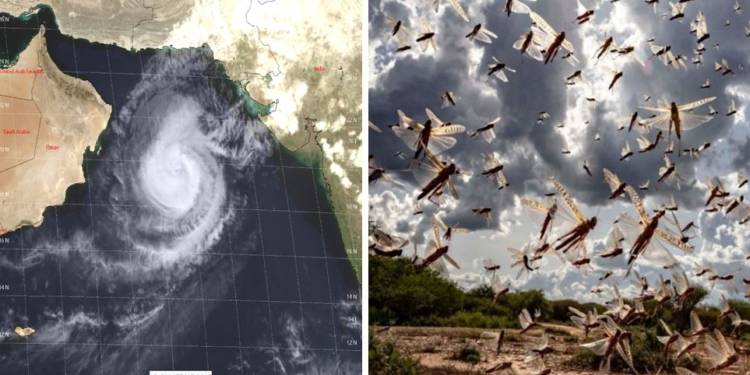Social media is rife with visuals of locust swarms forming multiple kilometre-long pathways in air, travelling in desperation to find a food source for the entire swarm. Ideally, a swarm can have up to 10 lakh locusts in it, although the numbers might vary. If visuals of the locust invasion of this year are anything to go by, the numbers are abnormally higher than usual.
A multiplicity of factors, ranging from climate change-triggered erratic weather behaviour to even Coronavirus, and subsequent lockdowns seem to have contributed to the immensity of the locust invasion in South Asia this year. However, before we move on to these issues, let us first get to know our little, yet formidable enemy.
What are locusts?
Locusts are not an unusual species. Essentially, they are insects, bearing very close similarities to the grasshopper family. However, unlike normal grasshoppers, their breeding capacity and longevity are unprecedented. While grasshoppers are harmless and live as adults for about 8 weeks, locusts are notoriously reproductive and live as adults for 10 weeks. Locusts prey upon green leafy vegetation and are well suited for moisture.
Where are these little devils coming from?
All countries have locusts. What all countries do not house, however, are the desert locusts, which are the one’s ravaging India currently. Desert locusts are formidable, to say the least, and have an unmatched breeding capacity. In just three breeding seasons, desert locusts can increase their kind by 16,000 times! Such locusts have descended upon us from Saudi Arabia, and the reasons we have earlier stated have much to do with their influx into India.
Climate change as an enabler of locust influx
A consequence of global warming has been the warming of the seas. Warming seas are increasing the potential energy in the system to trigger more powerful and frequent storms than normal. The Arabian Sea is a cyclone-prone system with the intensity of cyclones rising, and the effect of these storms are witnessed in the Gulf region, Iran, and the Indian subcontinent.
The locust infestation first started in Saudi Arabia’s deserts and extremely dry conditions. Although all was well until 2018, Saudi Arabia was pounded by two Cyclones that year, namely – Mekenu and Luban. This led to an abnormally high rainfall over the region, due to which vegetation flourished, and the environment was rendered moisturized than usual. This led to desert locusts breeding like never before, to the extent that it became impossible for them to remain in the Arabian Peninsula. Cyclone Kyarr which hit the coast of Oman in 2019 was the first super cyclone in the Arabian sea in 12 years.
The swarms of locusts, unable to stay in the deserts, and further enabled to travel due to altered wind currents, moved southward to Yemen and entered Africa creating a famine-like situation. They have impacted almost the entirety of eastern Africa and parts of North Africa.
The swarms of locusts then moved Northward, crossed the red sea, where they received all the rainfall they needed, and entered Iran and Pakistan. From Pakistan, these devils are now ravaging crops across Indian states.
Arabian Sea, which would earlier witness one or two odd cyclones in a span of five years is now seeing the same number, and more, in a single year. Scientists and Climate experts attribute this erratic behaviour of the Arabian Sea to climate change. That isn’t all. Erratic rainfall across Iran, Pakistan, and India in recent times has given rise to perfect conditions for desert locusts to fester and migrate. The cyclones of the same Arabian Sea initiated the outburst of locusts in the Arabian Peninsula in the first place.
Coronavirus led to the unabated proliferation of locusts
Meanwhile, the Coronavirus pandemic further pushed humans indoors, and occupied governments, who were trying to combat the disease. This left no time for respective authorities to deal with the menace of locusts this year.
With each passing day, and with every mile they cross, swarms of locusts feed, breed, multiply and mature. Because of Coronavirus outbreaks in Iran and Pakistan, the swarms were given a free run, and hence this also accounts for the vicious wave of locusts invading India and wreaking havoc in our farmlands.
Iran, particularly, usually acts as a buffer for locusts from entering Pakistan, and subsequently, India. However, this year, Iran was ravaged with CoVID-19, second only perhaps to China, the epicentre of the outbreak.
As such, even in Pakistan, not much focus and importance was laid at dealing with locusts, who are now proving to be lethal threats for India. In any case, not much could have been expected from the bankrupt neighbour to our West, and therefore, when Iran let the locusts go by, it was almost a given that they would be ravaging India.
What now?
There isn’t much which can be done now, and the invasion of locusts will also have to be tolerated by Indians among all the other tragedies of 2020. Although the Government will definitely try to inhibit the proliferation of locusts, the numbers this time around are just too tremendous to tackle. At a time when India is focusing all its energies towards fighting the pandemic, managing the locust invasion will definitely be a herculean task.
What we can pray for however, is that a Locust Plague is averted at all costs. Large swarms of locusts feed on crops across the regions through which they move, and will, therefore, be catastrophically destroying the agricultural economy of India, while severely threatening the nation’s food security.
India has extended its hand seeking cooperation from both Iran and Pakistan to fight the menace of locusts collectively. While Iran has responded positively to the same, Pakistan is maintaining a stony silence. Last year though, Pakistan had cooperated with India in battling locusts. What changed this year is a question which will perhaps be answered in the near future.

































